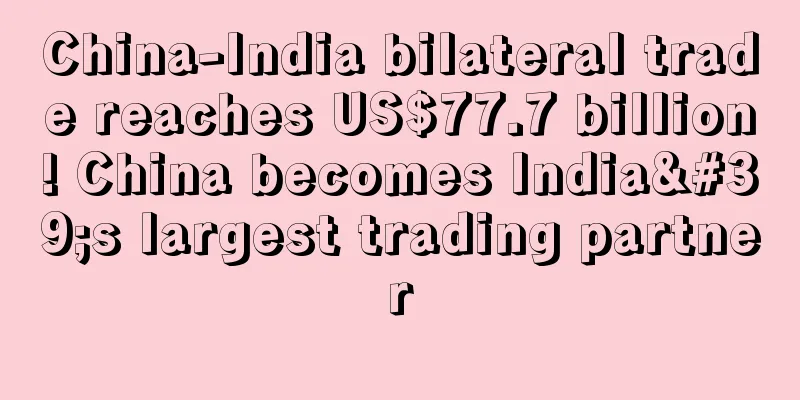China-India bilateral trade reaches US$77.7 billion! China becomes India's largest trading partner

|
In 2020, the new coronavirus raged around the world, many countries suffered heavy blows, and their economies were severely damaged. However, thanks to strict epidemic prevention policies and measures, China's epidemic was effectively controlled, and it was the first to resume work and production. In 2020, it actively played the role of the world's factory and exported a large amount of materials to many countries.
Among them, the total two-way trade volume between China and India reached US$77.7 billion, and the total value of China's exports to India reached US$58.7 billion, while the total two-way trade volume between the United States and India was US$75.9 billion. China surpassed the United States and once again became India's largest trading partner.
Although India has vigorously developed its local manufacturing industry in recent years to achieve independent development, it is still highly dependent on China's heavy machinery, telecommunications equipment, household appliances and other products. Taking electronic products as an example, smartphone brands from China occupy a large share of the Indian smartphone market, and four of the top five best-selling brands are Chinese brands.
India has a strong demand for China's home appliances such as air conditioners and refrigerators. However, due to the limitations of its manufacturing technology level, India also has a strong demand for these products' semi-finished products, spare parts and important components. India is highly dependent on China's integrated circuit boards, auto parts and other essential components and spare parts for production. In addition, India is also highly dependent on various production raw materials such as steel and alloys.
In order to promote the development of domestic manufacturing and reduce imports, the Indian government implemented the PLI (Production Stimulus Program) and introduced outstanding talents from outside to help improve the level of manufacturing. However, Singaporean economist Amitendu Palit said that India still has a long way to go if it wants to get rid of its dependence on China.
“ The PLI scheme will take at least four or five years to create new capabilities in specific sectors. Hence , the dependence on China will continue. ”
In 2020, Sino-Indian relations deteriorated due to the border standoff, but recently, the two sides reached a partial agreement on the border issue, and relations between the two countries began to ease. India also reopened 45 investments by Chinese companies, and Sino-Indian trade and other exchanges are expected to resume.
As tensions between the two countries ease, the Indian government is gradually relaxing some restrictions on Chinese companies and imported products, and the overall environment is becoming more friendly to Chinese companies and cross-border e-commerce sellers. Cross-border e-commerce E-commerce market E-commerce platform |
Recommend
Meikeduo won the second quarter! Net income was US$2.6 billion and 275.2 million items were sold
Recently, Latin American e-commerce giant Mercado...
UK retail sales growth slowed in August, but clothing industry remained strong
UK retail sales growth began to slow gradually in...
$240,000 per second! Temu may return to the Super Bowl
Temu was quietly launched in the United States in...
What is CJdropshipping? CJdropshipping Review, Features
CJdropshipping is mainly aimed at overseas merchan...
What is MailZone Overseas Postcard? MailZone Overseas Postcard Review, Features
MailZone Overseas Postcard is a direct mail automa...
What is CONTACT PAY? CONTACT PAY Review, Features
CONTACT PAY is the leading payment gateway in eme...
Buy a new sofa for $50! Amazon and Walmart returns are popular on TikTok
A new way of shopping has emerged in the United S...
The return rate in the United States has exceeded 20%! Online clothing retailers have new strategies
Recently, e-commerce service platform Nosto relea...
What is Xuanpinhou? Xuanpinhou Review, Features
Xuanpinhou is a free big data engine that integrat...
What is Colimonde? Colimonde Review, Features
Colimonde was founded in 2013 and is headquartered...
What is Whalet? Whalet Review, Features
Whalet (Chongqing Whalet Technology Co., Ltd.) mai...
What is Easync? Easync Review, Features
Easync integrates with many major platforms around...
Alibaba Dai Shan: This year's Double 11 will witness consumption vitality and enhance merchants' confidence in growth
On October 24, the 2022 Tmall Double 11 press con...
Wanlihui upgrades its "three-piece package for going global" to allow sellers to open an account in 1 minute and receive payments from 120 platforms
The 135th Canton Fair, which just closed last Sun...
What is Etsy Wholesale? Etsy Wholesale Review, Features
Etsy Wholesale was launched by Etsy in August 201...









